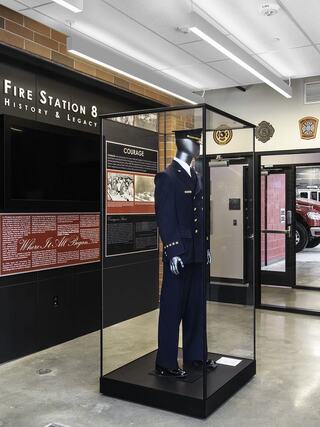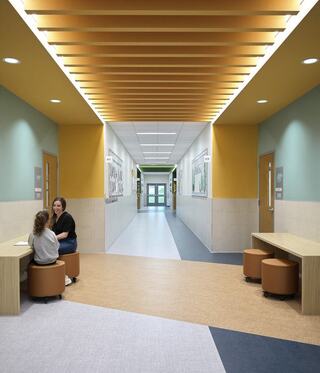
Leveling Up: Making Space for Esports
Published: 5.13.25
Category: Education, Projects, Design
Tags: Higher Education
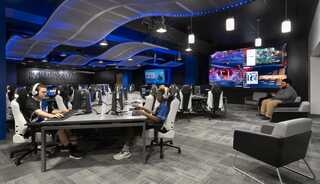
Esports, a form of competitive video gaming, has near universal appeal among young people as shown by a 2024 Pew Research Center study, which found that 85% of U.S. teens play video games and 41% do so daily.
THE RISE OF ESPORTS IN EDUCATION
Not surprisingly, esports are also thriving in education where students from middle and high school to colleges and universities are joining teams to compete in this burgeoning arena. In higher education, many colleges have formalized esports within their athletic programs and recognize the collateral benefits to academic achievement, school engagement and career preparation.
.png)
ESPORTS FACILITIES EMERGE
In the competitive landscape of higher education, a well-organized esports program helps colleges recruit and retain students. In fact, many colleges are creating dedicated esports facilities designed to serve the unique needs of competitive gaming. These new spaces are proving to be dynamic hubs where gamers can connect, collaborate and compete.
In tandem, architects are bringing their expertise to the challenge of creating spaces that optimize player experience and reinforce the value of esports to students and college communities. FGMA designers recently completed esports facilities for St. Louis Community College and Southwestern Illinois College. While every school will have unique needs, lessons and insights from these projects have broad applicability.
THE BASIC INGREDIENTS
A fundamental lesson is that creating a high-quality esports space can be economical, especially in comparison to other types of athletic facilities. Southwestern Illinois College (SWIC) expanded and renovated an existing cyber lounge while St. Louis Community College (SLCC) repurposed an under-utilized conference room.
The basic ingredients for an effective esports space are a large room with an open footprint to accommodate distinct activity zones, the infrastructure to support high-speed internet and state-of-the-art gaming equipment, comfortable furniture as well as good acoustics.
Bottom line: Esports is an immersive experience, and players need an environment free from glare and outside distractions.
Multi-Purpose Cyber Lounge at Southwestern Illinois College
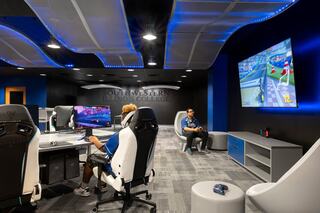
At SWIC, an existing cyber lounge on its Belleville campus was renovated to house the growing esports program which students can join either as a club or team member. This space, next to the campus café in the Main Complex Building, was optimal because of its open floor plan with an adjacent office providing the cabling and infrastructure to support the expanded space.
Today, SWIC’s cyber lounge still functions as a computer lab and study/drop-in space that now also accommodates up to 50 players for esports competition. The primary game play area is an X-shaped main table at the center of the arena with lounge space, individual gaming stations and lockers on the periphery.
SWIC’s gaming stations feature flexible seating so that players can be reconfigured during competitions, zones for distinct types of game play, lockers, lounge space and accessible design elements that support the needs of all students.
Esports Arena at St. Louis Community College
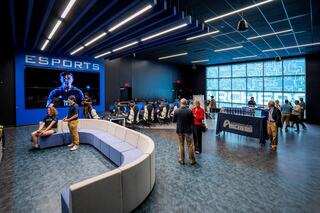
STLCC has transformed an under-utilized conference room in a centrally located academic building for its esports program. The new esports arena features three distinct activity zones including the competitive gaming area, which consists of a long row of stations in which players face each other. A wall-sized video screen enables players to see what their teammates are doing while ergonomic furniture enhances their ability to quickly move around and strategize.
A secondary zone includes a curved sofa where students can gather to practice and socialize, while a third area features standing height tables where players can quickly connect during competitions. Each area is designed to support the team-based nature of esports in which players are working together.
CREATING AN IMMERSIVE EXPERIENCE
Acoustics are critically important in esports spaces to help players focus. Acoustic panels ceiling tiles, and baffles contain noise while dimmable lighting helps players focus during competition. At STLCC, the acoustic panels double as “tack-up” space for team notices and information-sharing. Video walls with live-streaming capabilities enhance both the player and spectator experience.
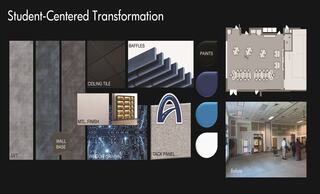
Project board highlights the transformation of an underutilized space at St. Louis Community College and the layout, design and materials that transformed it into their new esports arena.
BRANDING THE ESPORTS SPACE
Branding is an effective tool to build pride and identity. Both SWIC and STLCC have introduced design elements in their esports facilities that celebrate the joy of esports and school pride in their esports athletes.
At STLCC, designers covered an existing glass curtain wall with graphics that feature symbols of the mapping process embedded in video game play – a compelling visualization of what makes esports exciting. This design solution embodied the dual benefits of enhancing player experience by minimizing outside distractions and boosting pride in Archer Athletics.
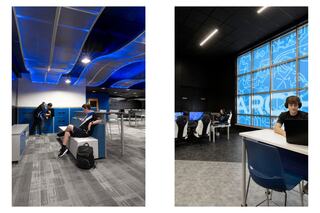
A ROBUST FUTURE
The comparatively small-scale renovations that SWIC and SLCC implemented have transformed existing spaces and created new homes for esports athletes who represent a sport that is popular throughout the world. Both colleges have invested in a student-centered, tailor-made environment that foretells a robust future for esports.
A STLCC administrator notes, “I was giving a tour of the space to a potential student who was deciding which school he’d attend on the basis of its esports team … when he walked into this space, he stopped and said, ‘No, this is the room that I want to play in.’ He chose our college based on the experience of being in that room.”
"This new arena represents more than just a physical space; it embodies our commitment to embracing new technologies and fostering student engagement through innovative programs," said STLCC Athletic Director Sharon Marquand.
FGMA Senior Associate Katie Corey says, “The world of esports is ever evolving, and its benefits, for students and schools, have fueled its explosive growth in education. FGMA is honored to be a trusted resource and design partner on a mix of esports facilities, including those completed at Southwestern Illinois College and St. Louis Community College, as well as projects underway at Mascoutah Middle School and the new Cahokia High School.”
News & Insights
All Articles
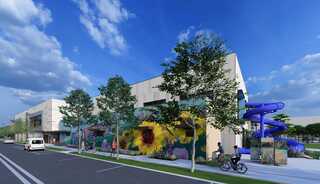
How City Planning, Zoning and Regulations Shape Successful Architecture Projects

